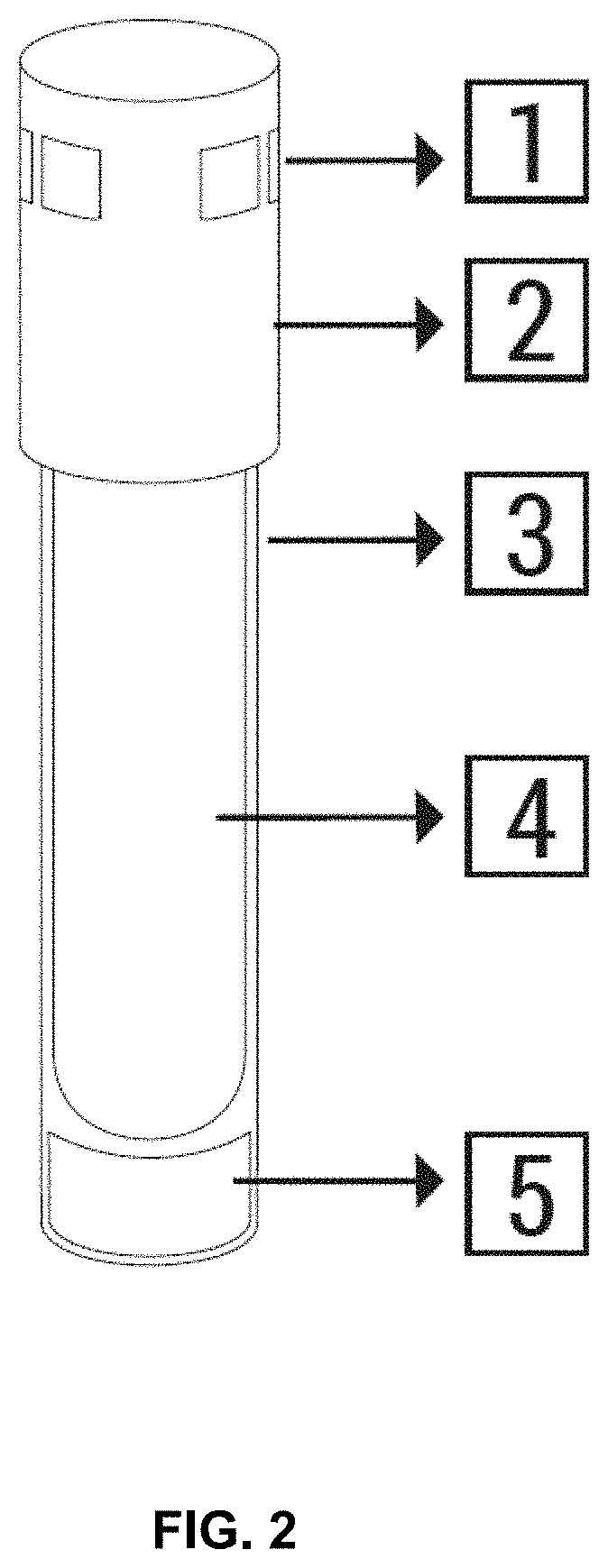Biological indicator for determining the efficacy of a steam or heat sterilization process and its method of use
a technology of biological indicators and steam or heat sterilization, applied in the field of biological indicators, can solve the problems of significant time and resource expenditure, affecting the overall cost of the biological indicator per se and the general cost of sterilization processes, and achieve the effect of more time- and cost-effectiveness
- Summary
- Abstract
- Description
- Claims
- Application Information
AI Technical Summary
Benefits of technology
Problems solved by technology
Method used
Image
Examples
example 1
[0105]The example was carried out using an F. & M. Lautenschlager GmbH & Co. resistometer, which allows to conduct sublethal time expositions in order to evaluate predictions of a biological indicator.
[0106]BIONOVA BT224 biological indicators, which are the fastest indicators currently available in the market, were used for testing during the example along with the biological indicator of the present invention in order to obtain comparison data.
[0107]Fast readouts were obtained using an IC10 / 20FRLCD incubator. Extended readouts (7 days) were carried out in humidity chambers with 80% relative humidity at 60° C.
[0108]Culture medium contained in the ampoules of the biological indicator of the invention consisted of 1 g / L of bacteriological peptone; 1 g / L of yeast extract and 0.5 g / L of L-valine.
[0109]Fluorescence readouts with the biological indicator of the invention were carried out within 0-20 seconds according to the method of the invention.
[0110]20 biological indicator of the inve...
example 2
[0113]Conditions of Example 1 were replicated, except for the variations indicated herein.
[0114]Ampoule contents of the biological indicator of the invention were as follows: Bromothymol blue was used as colorimetric component of the culture medium and 0.1 mg / ml 8-anilinonaphthalene-1-sulfonic acid as fluorophore. 0.5 g / ml albumin was employed as exogenous sensor protein.
[0115]Along with the ampoule, the carrier containing 2.5×106 CFU of Geobacillus stearothermophillus ATCC 7953 spores was laid inside the tube. Exposure times were conducted at 132° C.
PositivesPositives20 min7 daysExposurePositivesPositivesreadoutreadoutTimeInstant7 daysBIONOVABIONOVA(seconds)readoutreadoutBT224BT22412020 / 2020 / 20 20 / 2020 / 20 15020 / 2013 / 20 20 / 2014 / 20 18014 / 207 / 2015 / 205 / 20210 5 / 200 / 20 5 / 200 / 20240 0 / 200 / 20 0 / 200 / 20
example 3
[0116]Conditions of Example 1 were replicated, except for the variations indicated herein.
[0117]Ampoule contents of the biological indicator of the invention were as follows: 5-Bromo-4-chloro-3-indolyl β-D-galactopyranoside was used as colorimetric component of the culture medium and 0.1 mg / ml 8-anilinonaphthalene-1-sulfonic acid as fluorophore. 0.5 g / ml casein was employed as exogenous sensor protein.
[0118]Along with the ampoule, the carrier containing 2.5×106 CFU of Geobacillus stearothermophillus ATCC 7953 spores was laid inside the tube. Exposure times were conducted at 132° C.
PositivesPositives20 min7 daysExposurePositivesPositivesreadoutreadoutTimeInstant7 daysBIONOVABIONOVA(seconds)readoutreadoutBT224BT22412020 / 2020 / 20 20 / 2020 / 20 15020 / 2019 / 20 20 / 2014 / 20 18016 / 205 / 2015 / 205 / 20210 6 / 200 / 20 5 / 200 / 20240 0 / 200 / 20 0 / 200 / 20
PUM
 Login to View More
Login to View More Abstract
Description
Claims
Application Information
 Login to View More
Login to View More - R&D
- Intellectual Property
- Life Sciences
- Materials
- Tech Scout
- Unparalleled Data Quality
- Higher Quality Content
- 60% Fewer Hallucinations
Browse by: Latest US Patents, China's latest patents, Technical Efficacy Thesaurus, Application Domain, Technology Topic, Popular Technical Reports.
© 2025 PatSnap. All rights reserved.Legal|Privacy policy|Modern Slavery Act Transparency Statement|Sitemap|About US| Contact US: help@patsnap.com


